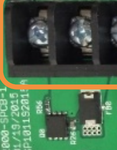Nabors
Newbie level 4

I've been working on a small personal project for an accessory control board for my car. One thing I want to incorporate is what one company calls "self-healing" over-current circuit. On a picture they posted of their circuit board, it looks like they are using a SMT device which is a little bigger than a DFN-8 MOSFET. I initially thought it was a PTC, but nothing in a SMT package is remotely high enough current.




